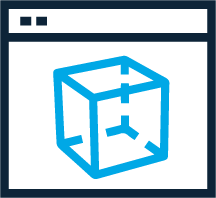Prototyping |
 |
What is it
Developing an early version of a product to convey the look (form-appearance) and feel (function-behavior); can be static or dynamic in nature but is typically built quickly.
Why use it
- Directly evaluate user interaction with a product or design concept to shape future design directions.
- Assess whether or not requirements are being met.
- Take chances with ideas and explore “risky designs” with minimal investment.
When to use it
- When the initial requirements and user needs have been documented but not fully validated.
- When performance requirements are well established but the form feature definition is still immature.
Level
Intermediate
Outcome
Evaluate
Group Size
2+ people
Suggested Time
60+ minutes
Prototyping Worksheet
How to do it
NOTE
Ensure that the team has gathered insight on the problem to understand user needs (Discover) and scoped the focus to understand the problem space (Define) before using this Prototyping Tool.
This tool is best done on a large whiteboard or with sticky notes on a large piece of paper.
The following order of exercises is one way to use the tool, but feel free to switch up the order depending on what the project needs and what the team is gravitating towards.
STEP 1
Start by filling out the “how might we…” statement at the top to define the problem and the goal of this prototype.
STEP 2
List requirements: Think back to the user needs and problem space to come up with requirements that this product needs to achieve.
STEP 3
Create vision board: What are current solutions to the above requirements? Think about products/solutions that currently exist in this space. What makes them not work for this application? Can designs from a completely different field be implemented in a novel way for this application?
STEP 4
Sketch mind map: Bring the list of requirements over into the sketch area. Do they roughly fall under “Looks Like” or “Works Like”? Start a mind map sketch to brainstorm individual features that can address these requirements. There can be multiple ways to solve a problem so feel free to write down and sketch out multiple features for each requirement.
STEP 5
Combine sketches: After having thought about individual features, explore how they would come together and integrate into a full product. How do they fit together? How would someone interact with it? Is there a particular order of operations for using this product?
STEP 6
Choose what to prototype: Is there a feature or interaction that should be explored more? What would benefit from viewing in 3D or acted out in an exercise?
STEP 7
Create paper/cardboard prototype: Gather some materials and resources that are easy to modify quickly, there are some suggestions on the worksheet. Use the prompts to think about what would be useful to physically prototype.
STEP 8
Collect feedback and make changes: Take these sketches and prototypes to the larger team and user groups to gather feedback. Iterate on the idea and design to mature prototype.
Benefits
- Encourages an experimentation mindset so you can test out ideas before implementing them
- Can be as lightweight or as complex as you need it to be
Benefits
- Encourages an experimentation mindset so you can test out ideas before implementing them
- Can be as lightweight or as complex as you need it to be
Benefits
- Encourages an experimentation mindset so you can test out ideas before implementing them
- Can be as lightweight or as complex as you need it to be
Challenges
- This is a purposefully broad tool because you can take it in many different directions.
- Prototype is often confused with MVP or “mini” versions of a full working something. Be sure to discuss the purpose of prototyping and understand the difference.
Combine With
- Community Map, Stakeholder Identification, Personas, and PAINstorming to understand user needs
- Problem Framing to define the problem
- Simplicity Cycle to guide how much to simplify or mature your prototype
Additional Resources
Department of Defense Prototyping Guidebook: DOD-specific guidance on prototyping


